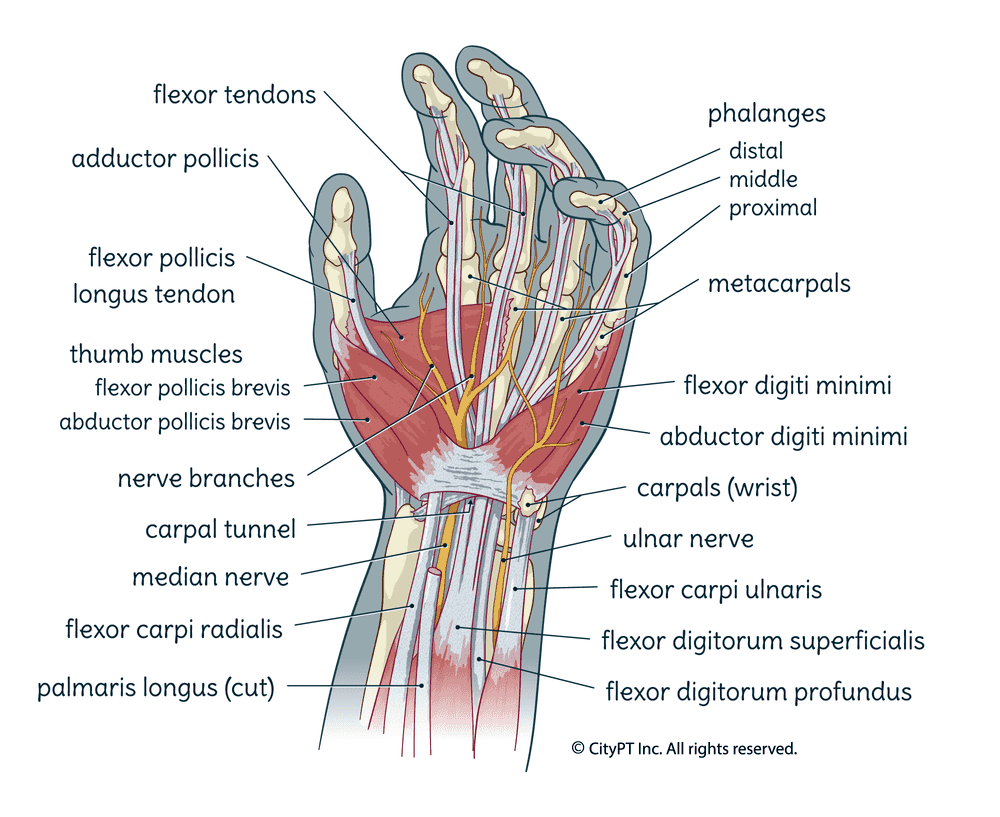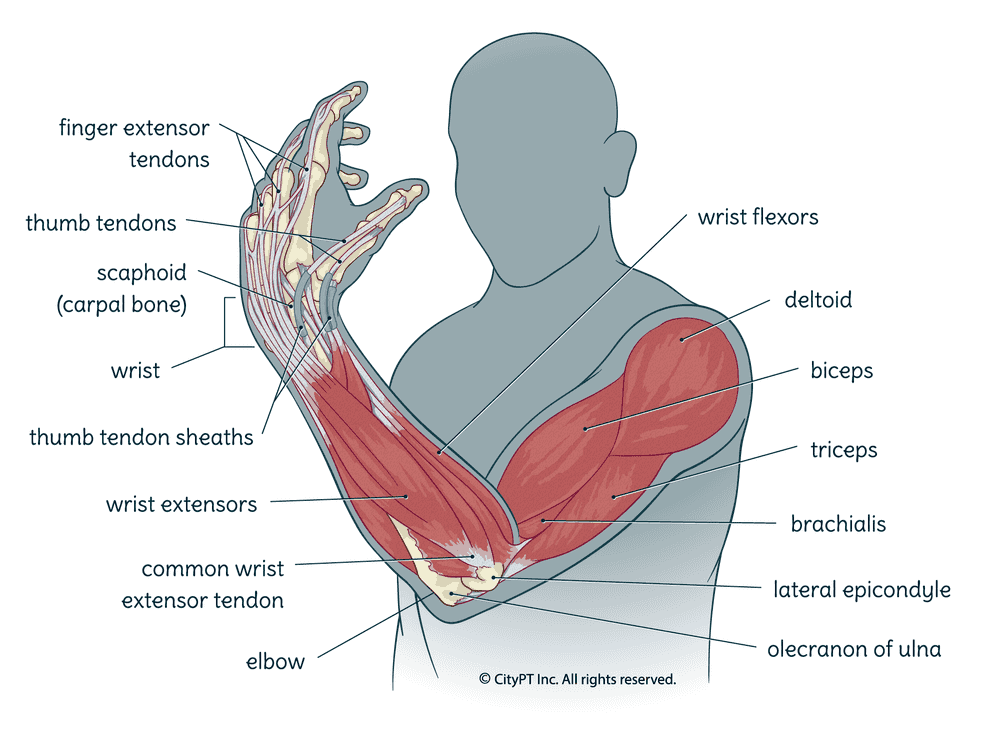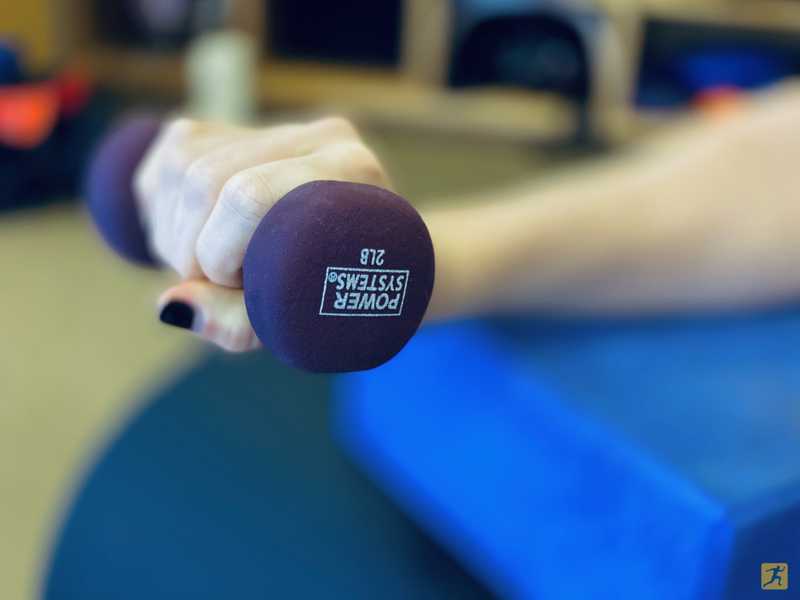If you've ever jammed your finger or strained your forearm muscles after gripping something too hard, you might appreciate the importance of being able to use your elbow, wrist, and hands without pain. Stiffness or pain can quickly make your everyday activities feel like a struggle, or even impossible.
Whether you work at a computer, play sports, or perform manual labor, there's a good chance you've had to deal with pain or injury of the hands, wrists, or elbows.1 The right knowledge and guidance from a medical professional can help to manage and prevent the onset of pain.
This article will explain how occupational therapy and physical therapy are effective for wrist pain, hand pain, and elbow pain. Plus, it'll provide tips for choosing a provider, home treatment, and prevention.
Table of Contents
- Everything Is Connected
- Symptoms of Elbow, Wrist, and Hand Dysfunction
- What Are Common Causes of Elbow, Wrist, and Hand Pain?
- Treatment Options for Distal Arm Pain
- How to Prevent Pain
- Keep Your Dexterity Intact
Everything Is Connected
There are 27 bones in the hand, with 8 of them (the carpals) articulating with forearm bones (the radius and ulna) to create the wrist. It's what makes the hand so dextrous and allows us to do everything from performing brain surgery to painting a portrait.
When it comes to the anatomy of the hand, wrist, and forearm, there's a great deal of overlap between muscle function and connective tissue support. This allows them to function in a coordinated fashion. Lower arm function runs smoothly until a small hitch in one bone, joint, or tissue starts to throw it all off.

For example, the muscles that allow us to grip something runs between the elbow and fingers. This is why too much gripping can manifest as elbow or forearm pain.
Symptoms of Elbow, Wrist, and Hand Dysfunction
What kind of pain might you experience in the elbow, wrist, and hand regions? It can be acute (sudden onset) or chronic (long lasting). Let's review.
- Dull ache
- Shooting pain
- Throbbing pain
- Muscle stiffness or spasms
- Difficulty coordinating meaningful movements
- Tenderness to touch in the surrounding musculature
- Tingling or numbness, particularly in the forearm or fingers
- Weakness with gripping, pinching, twisting, lifting, etc.
What Are Common Causes of Elbow, Wrist, and Hand Pain?
There are many reasons you may start to experience pain in your hand, wrist, or elbow. Plus, more than one issue may be causing your pain, which can cause a compounding effect.
Overuse vs. Trauma
While overuse injuries tend to happen gradually, trauma happens suddenly.
We use our hands all day to type, text, drive, cook, and take care of ourselves. When we use our joints and muscles too much — or hold them in awkward positions — they can become inflamed and cause local overuse injuries.
Trauma, on the other hand, is a single event that causes damage to the tissue. This could be from a fall, sports injury, or car accident, to name a few examples.
Common Overuse Injuries
Let's touch on a few of the most common causes of pain, which are more typically chronic.

Carpal Tunnel Syndrome
The carpal tunnel is a small space in the wrist that contains bones, ligaments, and tendons. The median nerve, which controls movement and sensation in the thumb and first three fingers, runs through this space. When the tissues around the median nerve become inflamed, it results in carpal tunnel syndrome. Symptoms include numbness, tingling, and pain in the hand and wrist.
Cubital Tunnel Syndrome
The ulnar nerve — which controls sensation in the pinky finger and half of the ring finger — runs from the neck to the hand through a space in the inner elbow called the cubital tunnel. When this nerve becomes compressed, it results in cubital tunnel syndrome. Symptoms include numbness, tingling, and pain in the hand, wrist, and forearm.
Other Nerve Involvement
It's important to note that the nerves of the arms can become entrapped in several different areas between the neck and hand. While carpal tunnel syndrome and cubital tunnel syndrome are the most common injuries, realistically nerve injury and symptoms can occur in other soft tissues as well. More than one area of the nerve can be affected at once as well, known as a double crush injury.
Tendonitis
Tendonitis is a condition that involves inflammation of tendons, the tissue that connects muscle to bone, related to overuse and strain. The types of arm tendonitis that are commonly seen in physical therapy include lateral epicondylitis (tennis elbow), biceps tendonitis, and wrist tendinitis. It can also progress to tendinosis, where the structure of tendons become stiffer and more fibrous, affecting function.
Trigger Finger
The tendons that control the movement of the fingers are surrounded by a sheath of tissue. When this sheath becomes inflamed or the tendons become too fibrous, it can cause the tendons to catch or lock when trying to move the finger, resulting in a trigger finger. Symptoms include pain and clicking when trying to move the affected finger.
De Quervain's Tenosynovitis
The tendons that control the movement of the thumb run through a small tunnel on the side of the wrist. When these tendons and surrounding tissue sheaths become inflamed, it results in de Quervain's tenosynovitis. Symptoms include pain and swelling in the thumb and wrist that make it difficult to move the thumb.
Arthritis
A general term used to describe inflammation in the joints. There are many different types of arthritis, but the two most common forms that affect the elbow, wrist, and hand are osteoarthritis and rheumatoid arthritis.
- Osteoarthritis (OA): A degenerative form of arthritis that occurs when the cartilage, the tissue that cushions the joints, wears down beyond what is expected with aging and use. This can happen due to age, injury, or overuse.
- Rheumatoid Arthritis (RA): A chronic form of arthritis that occurs when the body's immune system attacks the tissues around the joints. The finger joints and wrist (both sides) are commonly affected by RA.2
Bursitis
Bursitis occurs as a result of inflammation of the fluid-filled sacs (bursae) that provide lubrication between tendons and bones. These sacs are designed to prevent painful friction. Bursitis in the elbow, wrist, and hand is less common than in other areas of the body like the shoulders, hips, and knees. However, olecranon bursitis (tip of the elbow), radial bursitis (outer wrist), and ulnar bursitis (inner wrist) can occur. Symptoms include pain and swelling of the affected bursa and surrounding tissues.
Ganglion Cysts
Ganglion cysts are noncancerous lumps that develop along any tendon or joint. They are most common in the hands and wrist.3 While they are not usually painful, they can cause discomfort and limit the range of motion in the affected area.
Common traumatic injuries
Fractures
Fractures are a break in the bone caused by a fall, impact, or poor bone health (osteoporosis). The most common type of fractures in the elbow, wrist, and hand are fractures of the distal radius (wrist), metacarpals (hand), and phalanges (fingers).
Dislocations
This occurs when the ends of the bones that make up a joint are forced out of alignment. The fingers and thumb, particularly the distal (end) joints, are vulnerable to dislocation.4 A forceful dislocation can also lead to an avulsion fracture. This means that as ligaments are pulled and torn, they pull a small piece of bone with it.
Sprains/Strains
A sprain occurs when the ligaments that connect the bones are overstretched or torn. Wherease a strain occurs when the muscles or tendons are overstretched or torn. Sprains and strains can happen acutely with a sudden impact or gradually with a slower onset due to overuse over time.
Treatment Options for Distal Arm Pain
There are a variety of ways to treat distal arm pain, ranging from home treatment to medical guidance.
Who Treats Elbow, Wrist, and Hand Pain?
Sucking it up and dealing with the pain is never a good solution when the elbow, wrist, or hands are involved. The function of the lower arm is too important not to take action. So who should you ask for help? You have a few options.
- A certified hand therapist (CHT): A CHT is either a physical therapist or occupational therapist that has undergone extensive special training including 4,000 hours of direct hand care and 3 years of clinical experience.5
- A physical therapist: Particularly one certified in orthopedics or CHT.
- An occupational therapist: Particularly one certified as a CHT.
- Your primary care doctor: Who will most likely refer you to a specialist.
- A specialized physician: Such as an orthopedic surgeon, rheumatologist, or neurologist (depending on the suspected underlying causes or condition).
Which Provider Do I Choose for Hand, Elbow, or Wrist Pain?
Regardless of the underlying cause of your pain, understanding how to protect, heal, and optimize your joints is essential for a sustainable recovery. This is what makes care from any CityPT therapist, particularly a certified hand therapist, your best choice for hand, elbow or wrist pain.
If hand therapy doesn't help you achieve your goals, we will refer you to an orthopedic surgeon or another specialized physician for additional tests. However, having a CityPT physical therapist or occupational therapist as your primary musculoskeletal health provider will be a better use of time and money because we specialize in bone, muscle and joint disorders.6
Treatment: What to Expect from Hand Therapy
The goal of hand therapy is to relieve pain and restore any lost function. Specific treatments can involve one or more of the following:
-
Education: First and foremost, you will gain extensive knowledge about the cause of your pain and how to manage your pain effectively. Plus, you'll learn how to modify any necessary activities to promote tissue healing.
-
Pain relieving modalities for short-term relief: This can include heat, ice, ultrasound, electrical stimulation, diathermy, whirlpool, and light therapy.
-
Exercise prescription: Exercise is an important part of any hand therapy program. The type and intensity of your exercises will depend on the specific condition being treated. Your hand therapist will typically focus on range of motion, stretching, strengthening, coordination, and overall dexterity.
-
Manual therapy: This includes soft tissue and joint mobilization, which involves manually moving the joints and soft tissues to help improve range of motion and decrease pain. Plus, other specialized techniques such as nerve mobilization, tendon glides, and neuromuscular reeducation.
-
Custom splinting: This is often used to protect the joints and soft tissues while they heal. It can also be used to position the joints in more optimal alignment to help improve range of motion and function.
-
Scar management: Scar tissue can lead to adhesions and impaired mobility, particularly in the wrist and hand. If you have any scars from previous surgeries or injuries, your hand therapist will work on minimizing their appearance and improving their function.
-
Activities of daily living training: This can include anything from cooking and cleaning to grooming and dressing. The goal is to help you regain as much independence as possible. If you're an athlete, your hand therapist can provide return-to-sport tips and techniques for your sports as well.
-
Ergonomic assessments and recommendations: If your pain is work related, your hand therapist will assess your workstation and tools you use daily, and make any necessary recommendations to help you stay pain free. They can assess any other setups that you use frequently too, such as in your car.
Can I Treat at Myself Home? When to Ask for Help
If your pain is mild or you aren't ready to see a medical professional (or if you're waiting to see a specialist) you might think to yourself that a DIY program is worth a try. When trying home treatment, it's important to pay close attention to your symptoms and start slowly to avoid the risk of further injury that comes with self-treatment.
Additionally, if you want to see a specialist NOW, consider seeing a virtual physical therapist for almost instant access.
DIY Pain Relief
Getting short-term pain relief at home is straightforward with the following strategies:
- Ice and heat
- Non-steroidal anti-inflammatory drugs (NSAIDs) like ibuprofen to address swelling
- Compression with an elastic bandage or tight-fitting glove
- Temporarily avoiding any activities that aggravate the pain
- Gentle exercise as listed below
Home Exercises
To get started with elbow, wrist, and hand exercises at home, it's best to focus on range of motion and grip strength. From there, you can add resistance to any of these movements with weights or a resistance band.
- Handball squeezes
- Finger pinches with a small ball or putty (between the thumb and each of the 4 fingers)
- Closing and opening the fingers (fist to spread fingers)
- Wrist flexion and extension (up and down)
- Wrist pronation and supination (rotation)
- Wrist radial deviation and ulnar deviation (side to side)
- Elbow flexion and extension (bending and straightening)
How to Prevent Pain
There are a few things you can do daily to help prevent pain in the wrist, hand, and elbow:
-
Pay attention to the way you position your arms throughout the day: Avoid excessive gripping (common with anxiety, with objects like a steering wheel), awkward positions with sleeping, etc.
-
Use proper ergonomics: When working at a computer, make sure your keyboard and mouse are at the correct height and that you take breaks often. In general, set up your desk and chair so that your elbows are bent to about 90 degrees. Your wrists should be able to rest comfortably and type while staying neutral - particularly avoiding extension. If you use a mouse throughout the day, you should consider purchasing one that is designed with ergonomics in mind.
-
Keep good posture: Outside of your office, make sure you are keeping good posture with other activities that may be putting strain on your body.
-
Exercise regularly: Strong, flexible, and coordinated muscles help support the joints and can prevent pain.
-
Sports management: If you're an athlete that practices a lot of repetition, remember to take appropriate rest days and cross train.
-
Bracing: If you participate in work activities or a sport that puts you at a higher risk for an injury, consider wearing a brace or ask how to modify your activity.
-
Be kind to your body: Promote optimal tissue health of your hands, wrist, elbow, and beyond with a healthy lifestyle. Stay hydrated, fill your body with the nutrients it needs, get enough rest, and be mindful of your mental state, to name a few.
By following these tips, you can help prevent pain in the wrist, hand, and elbow. If you do experience pain or are concerned about developing pain, be sure to ask for help sooner rather than later.
Keep Your Dexterity Intact
Don't leave the function of your distal arm to chance. Take action and preserve your dexterity and quality of life. That way, you can continue being independent with your daily tasks and participate in your favorite sports or hobbies.
To get instant access to care, book the next available appointment with a specialized CityPT Clinician.
This guide is intended for informational purposes only. We are not providing legal or medical advice and this guide does not create a provider-patient relationship. Do not rely upon this guide (or any guide) for medical information. Always seek the help of a qualified medical professional who has assessed you and understands your condition.
References
Footnotes
-
Ferguson, R., Riley, N.D., Wijendra, A. et al. Wrist pain: a systematic review of prevalence and risk factors– what is the role of occupation and activity?. BMC Musculoskelet Disord 20, 542 (2019). https://doi.org/10.1186/s12891-019-2902-8 ↩
-
Ruffing, Victoria. Rheumatoid Arthritis Signs and Symptoms. John Hopkins Arthritis Center. Accessed May 11, 2022. https://www.hopkinsarthritis.org/arthritis-info/rheumatoid-arthritis/ra-symptoms/ ↩
-
Gabbey, Amber. Gangion Cysts. Published January 24, 2022. Accessed May 11, 2022. https://www.healthline.com/health/ganglion-cysts ↩
-
Mayo Clinic Staff. Dislocation: First Aid. Mayo Clinic. Accessed May 11, 2022. https://www.mayoclinic.org/first-aid/first-aid-dislocation/basics/art-20056693 ↩
-
Hand Therapy Certification Commission. Certification FAQs. HTCC.org. Accessed May 5, 2022. https://www.htcc.org/certify/certification-faq ↩
-
McGill, Troy. Effectiveness of Physical Therapists Serving as Primary Care Musculoskeletal Providers as Compared to Family Practice Providers in a Deployed Combat Location: A Retrospective Medical Chart Review. Military Medicine, Volume 178, Issue 10, October 2013, Pages 1115–1120. https://doi.org/10.7205/MILMED-D-13-00066 ↩
